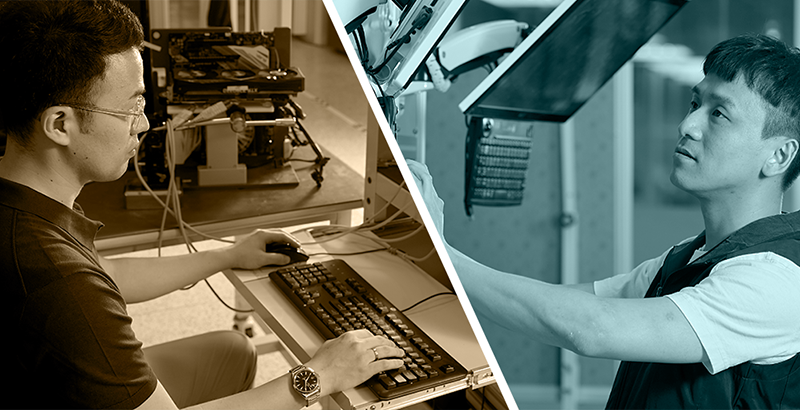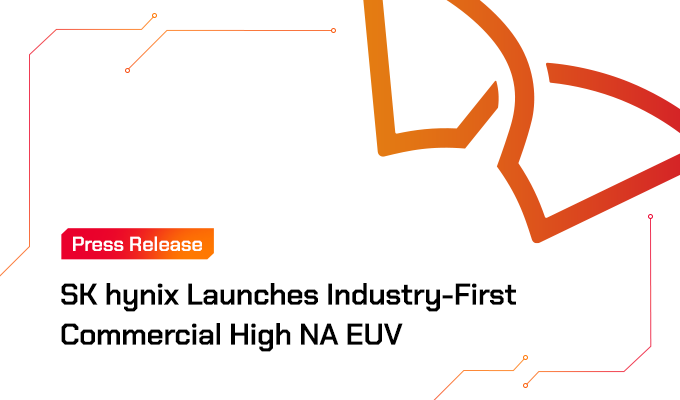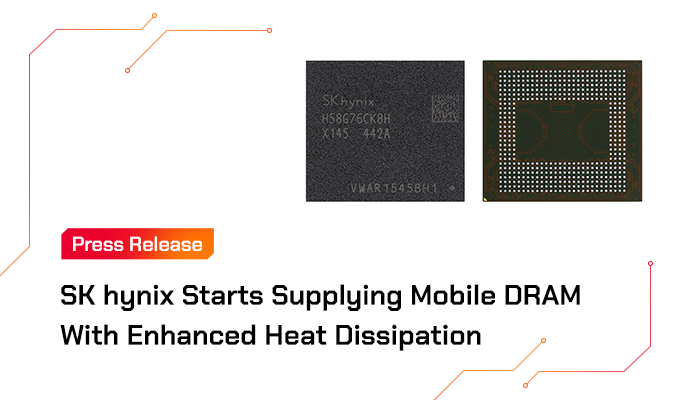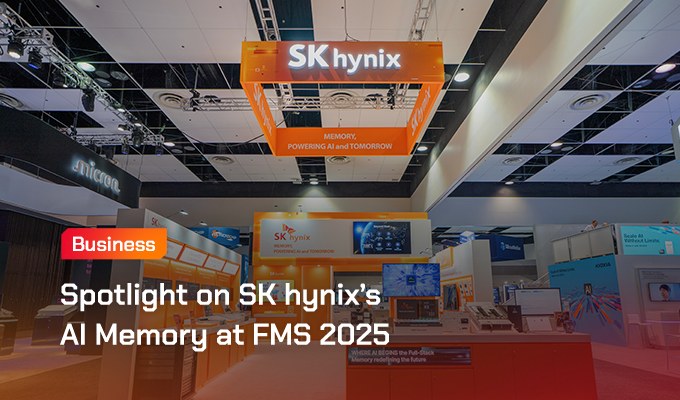
Adding the finishing touches to complete your work is crucial. If you fail to finish something well, you could risk losing all your efforts in vain no matter how hard you try. In the semiconductor developing sector, there is a department with a crucial role of putting the “finishing touches,” which is DRAM AE (Application Engineering, former System Engineering) of SK hynix’s DRAM Development & Business. SK hynix Newsroom visited DRAM AE to find out more in detail about its role and what capabilities are required for this role.
“Last Bastion” for Quality Verification of Developed Products… A “Troubleshooter” Who Discovers A Way for Success from Failure
To develop one single semiconductor product, many stages and tests, from design planning to module manufacturing, are required. Among these stages, the DRAM AE Office is responsible for the final verification in the system level, right before the stage of mass production. For this responsibility, experts specializing in different sectors from OS, BIOS, software to hardware are working together in teams, by different generations of products, verifying the completeness of products through diverse tests. To put it concretely, this verification includes validating whether the DRAM operates without a problem in a module, under different variables such as the actual usage environment, temperature, voltage, operation time, operation method, and so on. All of the newly developed products must pass this verification process before they can be mass-produced.
One of the other responsibilities of DRAM AE is finding a cause of a DRAM fail discovered during the testing process or providing samples to customers, so that the same problem would not recur in the future. In general, a “fail” in the semiconductor manufacturing process means a “failure.” However, for an AE person, a fail discovered is a precondition of “success”, not a “failure.” When a faulty product is found during the production stage, you will yield less finished products with the same amount of raw materials. On the contrary, when a potential fault can be found before the mass production and improved in advance, you can decrease the number of faulty products occurring in the production stage. In this fashion, DRAM AE is making its effort to discover a path to success from failure even now.

In addition, the DRAM AE Office enhances the completeness of a system that is being developed by customers, by participating in the development process. DRAM AE finds out potential problems that can occur when SK hynix’s products are applied to such systems and analyzes causes, contributing to the improvement of the system. Through these efforts, DRAM AE is building a strong relationship based on mutual trust with customers.
Key Capability: Reasoning the Cause of a Fail by Creating Various Scenarios
To hear more vivid voices on the tasks of the DRAM AE, SK hynix’s Newsroom met two people at the DRAM AE Office, Ho Young Kim TL (Technical Leader)1 of Mobile AE and Janghwan Cho TL of Computing AE, to ask a few questions.

Q. What are the tasks you are in charge of in your current team?
I’m in charge of AE tasks for a single DRAM applied to mobile devices such as smartphones. Mostly, I test whether the DRAM product works fine in the actual system environment of the mobile devices and check how it operates differently in various physical and environmental conditions. Also, when a fail occurs during tests, I find out the cause and solve the problem.
Q. What is the ambiance like within the team in general?
Overall, members of the team are young, and many of them have experience of work and business trips abroad. Thanks to this, the ambiance is vibrant and proactive. We have many foreign customers, and we trust and rely on each other as the team members have good foreign language skills with a good work capability. I feel reassured that I can work together with these colleagues.
Q. When do you feel a sense of accomplishment during the work?
We do a lot of system analysis regarding development, power competitiveness, performance, and workload. We do system engineering in various sectors. Sometimes, a problem occurs due to a specific system, and to solve it, you need to dig into that system in detail. These tasks help me a lot to improve the analytical skills. During the fault analysis, things that were unknown previously are discovered, and this sometimes solves other related issues at once. It makes me feel like I became an expert in such system, and that’s the moment I feel the sense of accomplishment.
Q. When do you find it difficult during work? How did you overcome such difficulty?
I have a hard time to find a solution when a difficult problem occurs. However, after you work hard to figure out the cause and solve the problem, with a thought that a problem must have a solution, the sense of accomplishment at such moment is significant. I think I can continue to analyze and solve failures through this motivation, even though it is difficult.
Q. What are the capabilities required for your current tasks?
Since we are a DRAM maker, knowledge in DRAM is a base. Following this, knowledge in software is the most important. It is because you can analyze the system’s workload only when you are well aware of the operation environment of the firmware within the actual system, as there are many application processors (AP) manufacturers in the mobile sector. Also, reasoning ability is very important. To analyze the cause of a fail, you need to be able to devise various scenarios by building up theoretical knowledge, and to be able to apply the situation to such scenarios when a failure occurs and reason the correlation between them. That’s why an understanding of system architecture is needed as well.
Q. Which efforts are you making for strengthening such capabilities?
As semiconductor development technologies are upgraded and new products are released, unexpected problems appear constantly. To deal with those problems, it is required to continuously accumulate information about industry trends or new technologies. For this, whenever a new AP is released, I try to study it by collecting related information through the product planning teams of the company or partners.
Q. What are the qualities needed for a newcomer for this job?
A proactive attitude and sense of responsibility are essential. In case of a DRAM fail or a quality issue, you need to be able to see the problem from different angles to solve it. Sometimes, you have to think about something you never thought of. If you are not familiar with a specific field, you need to find the expert in that field and ask directly. In these situations, a proactive attitude is a great benefit. As this is a department which solves problems, you must also have a sense of responsibility to deal with the problem you are in charge of until it is solved.
Q. Are there any messages you want to deliver to juniors you would meet in the future?
If there are people who are hesitating because they are unfamiliar with AE and our tasks, I want to tell them to just try applying for the job. Everyone has to learn from scratch anyway. I want to tell them that, once they are in, they can become excellent engineers, better than anyone else, through learning from colleagues with diverse backgrounds and experiences. Especially, I’d like to recommend this job to juniors who have a great curiosity in new things.
Active “Speak Up” Thanks to the Nature of the Tasks… Patience and Curiosity are a Must

Q. What are the tasks you are in charge of in your current team?
I am in charge of AE task for computing DRAM modules in PCs, laptops, and data centers. The current main product is DDR4, and I am in charge of AE tasks for this product. Mostly, when a sample is provided to the customer and a fail occurs, I look for the cause. I am also engaged in determining whether the responsibility of a failure lies with the customer or with us. I also work with related teams to correct the cause of the problem, if it is our fault. In this process, part of the job is securing a good relationship with the engineers of the customer through collaboration.
Q. What is the ambiance like within the team in general?
I think that my team is one of the best teams in SK hynix in terms of “Speaking up,” communication between seniors and juniors. Rather than worrying about something alone, we work and talk all the time. For identifying the cause of a fail and finding ways to improve, it is important to refer to the existing data. Among them, in particular, an intangible asset called “experience” is often essential. This nature of the job created a natural atmosphere where seniors share their experiences with juniors and juniors ask questions freely to seniors.
Q. When do you feel a sense of accomplishment during the work?
I felt great when I quickly analyzed the cause and drew a solution when a failure occurred right before mass production. Afterwards, I was very proud of myself when I received feedback from the customer saying, “Thanks to you and your prompt response, we could carry out with no problem on production schedule.” Personally, I don’t like repeating one task, but AE always allows me to do something new, from customer response to failure analysis and mediating different opinions among internal members.
Q. When do you find it difficult during the work? How did you overcome such difficulty?
One time, it took over a month to analyze a fail. It was a memory module scheduled for mass production. As a sudden failure occurred and the analysis didn’t make a progress for a long time, I was frustrated. Then, I thought to myself, “Still, I am the only one who knows about this fail this much.” I thought there was no other person or team to solve this problem than me. With a mindset that I am the expert who should solve the problem myself, I was able to focus on the problem and analyze the cause of the failure in the end.
Q. What are the capabilities required for your current tasks?
Creativity with sparkling ideas and concentration are important; but what’s more important is the ability to organize data to infer and make logical flows. Along with this, knowledge of design is beneficial. If you know the circuit operation structure, it is easier to estimate the cause in case of a fail. In fact, I often see members of designing or manufacturing field move to the AE Office. As they basically have a good understanding of situations, they don’t find it very difficult to analyze failures. Even though you are a newcomer with little design knowledge, you can still learn and it’s not impossible to master the job.
Q. Which efforts are you making for strengthening such capabilities?
To do the AE task well, it is important to keep studying new technologies and products. For this, I look for internal product planning data, as well as external conference materials. I also tend to look at the industry trends with great interest all the time. For example, I should be paying attention to issues, such as which system is to be developed by a particular system company and why the development schedule is changed, if this happens. I try to consider and predict how these issues would affect our work.
Q. What are the qualities needed for a newcomer for this job?
Patience and curiosity are important. When looking for a cause of a fail, it can take over one month when it takes long. In this process, you should be able to stick to the problem without being exhausted. Also, you should always be curious about the problem and be able to look up the existing data or materials to solve the problem. With these two qualities, you can easily adapt yourself to your work and grow steadily.
Q. Are there any messages you want to deliver to juniors you would meet in the future?
In AE, you tend to grow more like a generalist rather than a specialist, as you have to understand diverse fields. Maybe that’s why many juniors who didn’t know what they are good at get to discover a suitable role at the end, whilst doing AE tasks. If you are willing to learn, you can come and learn the work on-site. If you are not sure about your work aptitude, applying for AE can be a good option as you can discover your aptitude through various experiences such as HW and SW.
1SK hynix has unified different job titles into TL (technical leader), in order to eliminate the strict hierarchy among members and to encourage free horizontal communication.








